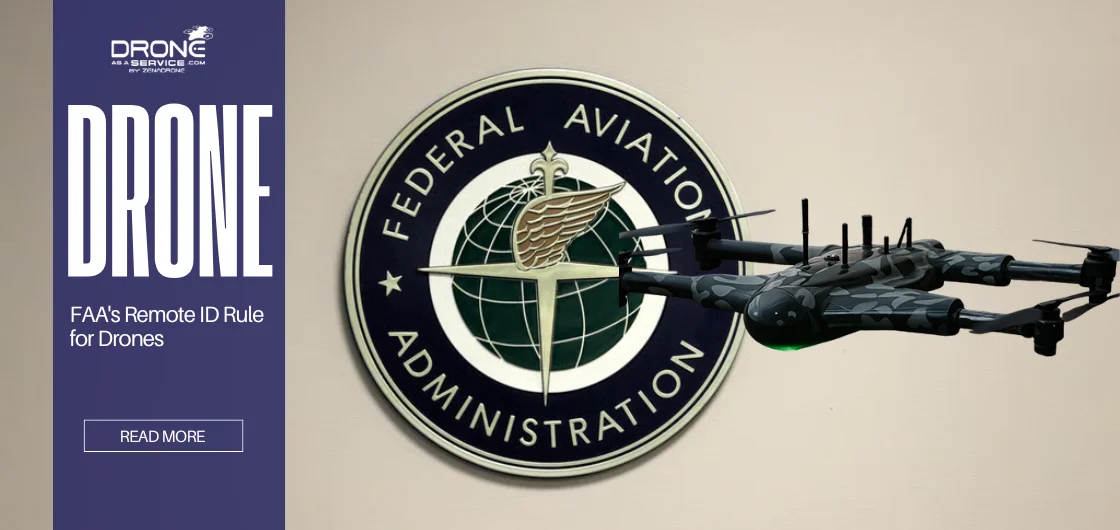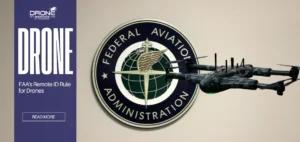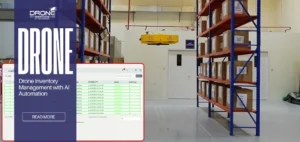FAA's Remote ID Rule for Drones

Drones have evolved from hobby gadgets to essential tools in agriculture, construction, security, and filmmaking. With this rapid growth comes the need for safer, more accountable airspace. To address these challenges, the Federal Aviation Administration (FAA) introduced the Remote ID rule—a digital “license plate” that broadcasts key drone information in real time.
This article explains what the Remote ID rule is, why it matters, and how operators can comply to ensure responsible and secure drone operations.
What is a Remote ID?
Remote ID is a broadcast identification system for drones that informs the world of their location. It makes the majority of drones broadcast their position. The information is transferred by radio. Imagine it is an automatic license plate of the day.
The primary objective of FAA Remote ID is accountability, security, and safety. It increases the safety of flying and assists drones in becoming a part of the national airspace. This is significant for the future of the FAA in terms of the expansion of drones.
The system allows authorities to monitor drones in the air. This is necessary for national security and law enforcement, particularly in sensitive locations. The FAA regulation applies to any drone that should be registered.
| Vehicle Plate | Remote ID System |
| The type of physical license displayed on the car is easily visible to the naked eye. | A digital broadcast, which the drone transmits, represents its current position. |
| It primarily informs you of what vehicle it is. | Identifies the drone and the control station. |
| It assists individuals in the field in locating and tracking the vehicle. | It allows the authorities to monitor the drone in the air. |
| Everyone can see it. | The broadcast information is shared locally only, hence the pilot’s privacy is maintained. |
Implementation of a standard FAA drone Remote ID is highly important. It quickly establishes responsibility within the drone community and secures the common airspace.
Why the FAA Introduced Remote ID
The rapid expansion of the drone industry has produced instant safety, security, and integration issues. The FAA has resolved these issues with its Remote ID (RID) rule that assigns each qualifying drone a digital license plate.
The Safety Crisis is Real
Drone flights that are unauthorized pose a direct threat to the human-crewed aircraft.
- Near Misses: Since 2021, the FAA has recorded over 2000 drone sightings in and around United States airports, with at least 63 incidents causing commercial planes to deviate.
- Altitude risk: Most investigations into illegal flight involve heights over 400 feet, the legal height. The average height in near-miss reports is about 2,200 feet, directly in the aircraft’s flight path.
Enforcement and Powering of Security
One important instrument of police and national security is remote ID.
Instant Traceability: RID transmits the drone’s position, altitude, and ID in real time. This allows the authorities to locate the operator of a non-compliant drone and makes enforcement not a possibility but an instant.
Differentiating Threats: The drone’s ID allows authorities to rapidly determine whether it is an authorized and compliant drone or a dangerous and malicious one.
The Future of Flight
Remote ID is not just security; it is the foundation of the advanced commercial application.
BVLOS and Delivery
RID is the FAA technical mandate that allows Beyond Visual Line of Sight (BVLOS) flights, required for large-scale delivery, inspection, and other long-range commercial work.
Urban Air Mobility
It is a key part of UTM, enabling safe, efficient management of thousands of low-altitude drones and supporting emerging applications like air taxis and advanced drone operations.
The FAA has been developing this regulation since 2016. The concluding regulation was released in January 2021. This schedule demonstrates a thorough development process that involved extensive public commentary and review. The regulation represents a planning process. The drone industry must get used to the new remote ID standard.
Categories of Remote ID Compliance
The FAA has three compliance options to suit the various types and applications of drones. This is an advantage to every pilot.
Standard Remote ID Drones
These drones have an in-built broadcast and comply with all FAA requirements at the factory. Since the end of 2022, all new drones sold in the United States must be a Standard FAA Remote ID model. These units always send their ID and the location of the control station, which sets the highest standard for compliance.
Remote ID Broadcast Modules
A broadcast module is a small gadget to add to a drone. It is aimed at older drones without hard-built hardware. The module allows retrofitting existing equipment, which is a more affordable method of complying with the rule without necessarily acquiring new drones simultaneously.
- Existing Drones: The module provides older drones with UAS Remote ID.
- Major restriction: The operators should always be within the visual range of sight (VLOS).
- Information sent: The module sends out the drone’s ID and takeoff point.
FAA-Recognized Identification Areas (FRIAs)
Simplified FAA-approved designated flying zones, called FRIAs, would enable the use of a drone without the use of Remote ID equipment. These are primarily educational organizations, community-oriented organizations, model aircraft organizations (like AMA chapters), and universities.
FRIAs offer a controlled, non-equipped flight area. The application is very intensive and makes the process safe for the people. No remote ID is needed in the geo-fenced areas.
What Information Remote ID Broadcasts
The broadcast only has specific, non-personal data—this is very important. This necessary data is transmitted locally through radio signals (Wi-Fi or Bluetooth). It can be scanned by surrounding smartphones, which must have the appropriate receiving application. Again, I am telling you that your specific residential address is not aired.
The system transmits the following aspects needed by each remote ID for drone flight:
- Drone ID: It’s either a unique number or a temporary session ID.
- Location: The exact GPS latitude, longitude, and geometric altitude of the drone.
- Velocity: The direction of the current that the UAS remote-ID device travels and the speed at which it travels on the ground.
Control/Takeoff Location:
- Standard RID: Where the pilot, or ground control station, resides.
- Broadcast Module: The position and height of the drone’s takeoff point.
- Timestamp: The exact time at which the information was produced.
- Status Emergency: Any statement of the emergency (standard RID only).
The FAA has carefully balanced privacy. The pilot’s personal information is not readily available to the masses. The correlation between the broadcasted ID, which can be associated directly with the pilot’s secure registration information, can only be done safely by the FAA and authorized law enforcement. This solution is safe, does not restrict operators’ privacy, and secures the moral drone pilots.
Key Dates & Deadlines for Remote ID Implementation
Significant events have marked the implementation time frame of FAA Remote ID. There was a considerable enforcement extension to operators. All drone operators must keep up with such deadlines. It is enforced now; check your status now.
| Phase | Deadline | Requirement |
| Rule Announcement | January 2021 | The FAA and the manufacturers officially issued the Final Rule. |
| Manufacturer Compliance | September 16, 2022 | Every new drone should have a Standard Remote ID. |
| Initial Operator Deadline | September 16, 2023 | All the operators of drones had to follow the rule. |
| Extended Operator Deadline | March 16, 2024 | This became the last deadline for all operators that existed. |
| Enforcement Phase | Post-March 16, 2024 | The non-compliant operators are fined, or the pilot certificate is actioned. |
The FAA knew it was hard to find broadcast modules for older planes. That’s why they pushed the deadline back to March 16, 2024 —a smart choice. It is enforced and continues throughout the nation. The FAA drone Remote ID requirement is now highly crucial, and you should ensure that your drone complies with it in case you face severe penalties.
How to Check if Your Drone is Remote ID Compliant
Before you fly, check to see if your drone is legal. Fortunately, there are some easy, verifiable methods of checking its status. Every pilot should do so immediately in case there is any suspicion.
1. Search for the Built-in Remote ID Label:
- An ordinary FAA-registered Remote-ID drone should carry a mark.
- The label indicates that the drone is compliant with the official ASTM standard.
- It is typically permanent, readily legible on the aircraft.
- Make sure that this mark is on the body of the drone or battery compartment.
2. See the Documentation of the Manufacturers:
- Read your drone’s manual or go to the manufacturer’s webpage.
- On a support page, they usually indicate the compliance status of the particular model.
- Firmware updates to slightly older models may also provide the required functionality.
3. Refer to the UAS Declaration of Compliance (DOC) List of the FAA:
- The FAA keeps a formal, public list of UAS models and modules that meet the rules.
- When your drone/module is listed here, it certainly complies.
- This validated database may be searched at the FAA site. The DOC list is the ultimate reference for the variety of all UAS Remote-ID equipment.
4. Check the FAA to see if your Dronezone registration is still valid:
- You have to give the Remote-ID serial number when you register your drone.
- If your registration indicates the desired serial number, you are compliant.
- A registered RID serial number guarantees full compliance status.
Remote ID Compliance Steps for Drone Operators
Compliance is not just about utilizing the correct equipment. You must also register properly with the FAA. This simple process is uncomplicated. Here are the steps for your clarity:
Recreational Drone Users (FAA TRUST, RID requirements)
Recreational users are supposed to be trained to meet certain requirements. To begin with, they have to complete the Recreational UAS Safety Test (TRUST). The exam is on basic safety, and it certifies competence. The recreational drones with 0.55 and above (250 or more) 0.55lb weight also have to be able to comply with Remote ID. Register all the drones with the FAA within one application, and include the Remote ID serial number of all equipped drones.
Part 107 Commercial Pilots
Part 107 governs the work of commercial pilots. They should also ensure that their aircraft comply with the FAA Remote ID requirement. This includes checking Part 107 license details. The aircraft will be registered separately on the DroneZone portal, and the Remote ID serial number should be provided. Failure to comply may result in suspension of the certificate; hence, be on guard.
Adding a Remote ID Module
The most appropriate solution to older, non-compliant drones would be to add a Remote ID module. It is quick and effective.
- Buy a certified module. Purchase one of the modules approved by the FAA in its DOC list to ensure it is certified.
- Connect the module to the drone and then fix it by screwing it onto the drone’s body according to the manufacturer’s instructions. Next, start the drone and set it up according to the directions.
- To test the module, fly a short distance in an open, safe area. Before your next mission, ensure it sends the right information and that the Remote ID works.
Registering Remote ID with the FAA Drone Zone
This is one of the most important things you must do with your Remote ID devices, so don’t forget to do it.
1. You can safely log in to the official FAA DroneZone website.
2. Choose your already registered drone, or make a new one where necessary.
3. Type the Remote ID serial number as printed on the device.
- Note: The RID label of the drone carries the serial number, or the module’s label carries the serial number.
- It usually does not match the aircraft’s serial number; hence, check it twice.
4. Identify the device as either a Standard or Broadcast module.
5. Check the update to your registration and save your changes. You are now officially in line.
Remote ID for Enterprise & Industrial Drones
Enterprise fleets have distinct compliance issues on a large scale. They frequently fly dozens of aircraft with far-reaching geographical coverage and numerous missions. ZenaDrone line and other commercial platforms must manage compliance on both large and small levels, and advanced firmware and centralized fleet monitoring are necessary.
The ZenaDrone 1000, IQ Nano, and IQ Square series are all made for business use. They can perform complicated tasks like BVLOS over long distances, mapping on a large scale, and inspecting infrastructure at a high altitude. For high-value operations, UAS remote ID must be followed.
Integration
Enterprise platforms are developed with built-in, verifiable FAA Remote ID software. This is their proprietary flight-management software that is programmed into this firmware.
Monitoring
Fleet-management dashboards will be proactively used to monitor the compliance status of all the drones in the fleet. They also ensure that every aircraft is equipped with appropriate, up-to-date, compliant firmware installed correctly before deployment.
BVLOS Enablement
BVLOS insists on stable and constant Remote ID broadcasting. This tracking feature opens the FAA waivers required for extended-range operations. Thus, a commercial Remote ID platform is an essential business asset.
Drone as a Service (DaaS) maintains compliance with regulations in its commercial fleets. This interest in compliance helps our clients to achieve the success of their missions and safety. The drone Remote ID is vital to long-term business continuity and growth because it is a reliable FAA solution.
Privacy, Security & Public Concerns
When a public broadcast system was first implemented, people were understandably worried about privacy. Many pilots are concerned about letting strangers know where they are. We understand why pilots are worried, which is a valid concern.
The FAA, on the other hand, put a lot of thought into how the FAA Remote ID system would work. The public gets the drone’s location and a unique serial number (also called a Session ID)—nothing more. They don’t get the pilot’s name, phone number, or home address. The data that is sent out is purposely anonymous to the public.
- Session IDs: The FAA is making plans for Session IDs. These temporary numbers are easy to tell apart and change for each flight. They are linked to a specific registration but hide the drone’s permanent serial number.
- Encrypted communication: In the future, there may be more advanced ways to communicate that are encrypted. This would further enhance the security of the transmitted data for all parties.
For example, compare this to other ways to get around. Your car’s license plate is easy to see for clear accountability. The remote ID for drones works similarly. But it only securely connects the ID to the operator through the FAA. Only law enforcement and national security agencies that have permission can see the owner’s personal registration information. This difference is important for the operators’ safety and the public’s trust.
Penalties for Non-Compliance
The compliance deadline officially passed on March 16, 2024. The FAA now enforces the FAA Remote ID rule nationwide and in all jurisdictions. Operators who don’t follow the rules will face serious and immediate consequences. Ignoring this rule is not worth the huge financial and professional risk.
If you don’t follow the rules, you could face:
- Civil Fines: The FAA can fine people up to $27,500 for each violation.
- Certificate Suspension/Revocation: Part 107 commercial pilots could lose their remote pilot certificate permanently. This would stop all legal commercial flights immediately.
- Criminal Penalties: If someone repeatedly breaks the law, they may face criminal penalties. These can be as high as $250,000 in fines or up to three years in jail.
- Flight Bans: The FAA can legally stop a pilot who doesn’t follow the rules from flying UAS remote ID operations forever.
- Confiscation: If you keep breaking the rules on purpose, the authorities may take your drone equipment.
The FAA is very serious about keeping airspace safe—it’s their main job. Recent actions against careless pilots prove this commitment beyond a doubt. Don’t put your business or hobby at such high risk. Before every flight, ensure your FAA drone remote ID is working correctly.
Remote ID’s Role in the Future of Drones
This new rule concerns a lot more than just current safety issues. It is a very important foundation for the next era of drone technology, which will be highly automated. Remote ID opens up a huge new area for the industry to grow quickly.
- BVLOS Operations: The key to Beyond Visual Line of Sight flights is reliable, real-time identification. It is the most important thing the FAA needs for BVLOS waivers and permissions.
- Urban Air Mobility: Complete tracking systems are needed for future air taxis and high-density urban operations. Remote ID gives UAM systems the openness they need to work safely.
- Drone Delivery: Big companies like UPS and Amazon Prime Air need to be able to track their fleets at all times. This FAA Remote ID system makes things safer and greatly speeds up the process of getting government approval.
- Integration with UTM: Remote ID works perfectly with future Unmanned Traffic Management (UTM) systems. UTM will actively monitor the flow of automated drone traffic to ensure smooth operation.
Remote ID for drones is a real “game-changer” for the industry because it builds trust between the public and the government. It doesn’t stop flights; it’s an important step needed for drones to be used worldwide regularly.
Best Practices & Tips for Operators
We want to make it easy and ensure you always follow the rules when you fly. Here are some important, useful tips for all drone pilots. Following these rules will keep your flights safe, legal, and stress-free.
- Checks for Remote ID Before Flight: Always check that the system is working properly by doing a quick check. Some drones do a pre-flight self-test (PFST) automatically, which is useful.
- Keep Your Firmware Up to Date: Manufacturers often release updates to keep up with compliance standards. As soon as a new firmware version for your remote ID for the drone device comes out, install it.
- Keep RID Documentation: Always have a physical or digital copy of your drone’s compliance status with you. This could be a photocopy of your FAA registration card.
- Know your serial number: Make sure you have the specific FAA Remote ID serial number written down on hand. You will need it to update your registration and any FAA inspections on-site.
- Have a backup plan: Consider keeping a spare one on hand if you use a broadcast module. When a module fails on a commercial job site, it costs a lot of money.
- Follow the FRIA Rules: If you fly in a FRIA, make sure you know where the boundaries are. It is against the rules and dangerous to fly outside of a FRIA without the right FAA drone remote ID.
Global Comparison – Remote ID Regulations Worldwide
Of course, the United States isn’t the only country that has to follow this important rule. Many other international aviation organizations are working toward similar, parallel requirements. The main goal is to ensure airspace safety worldwide for international travel. The idea of a UAS remote ID is really a global safety effort.
| Region/Country | Regulation Type | Notes |
| EU (EASA) | Network & Broadcast ID | Most people had to follow the rules by January 1, 2024. Authorities must also have a digital record of operators. |
| Japan | Mandatory Remote ID | This requirement has been in effect since June 2022 and is strictly enforced for all applicable UAS operations. |
| Canada | Expected 2025 adoption | Transport Canada is working hard to make its rules more like those in the US and Europe. New rules will soon be introduced. |
The increase in drones worldwide shows that FAA Remote ID technology is absolutely necessary. It also shows that people all over the world are committed to safely adding drones to the NAS. The FAA rule is a standard that will be around for a long time and will only become more common.
Bottom Line
Remote ID (RID) is not a problem with the regulations—it is the most important thing that will make the drone industry grow in the future. This rule starts a new era of openness and responsibility, the most important step toward safer skies.
Embracing RID opens up a huge world of possibilities for advanced, automated operations, such as Beyond Visual Line of Sight (BVLOS). Following the rules today means you’re ready for the challenges of tomorrow and helps keep the public’s trust in this cutting-edge technology.
Operators need to ensure that their FAA Remote ID device is compliant right now—don’t wait. Make sure your drone is registered and that you update the firmware quickly and correctly. For long-term safety, we strongly urge all pilots to fully and quickly adopt this UAS Remote ID standard.
Drone as a Service (DaaS) is ready to help you follow the rules and speed up your progress toward advanced flight operations.
Read Our Other Blogs

14 November 2025
FAA’s Remote ID Rule for Drones
FAA’s Remote ID Rule for Drones Drones have evolved from hobby gadgets to essential tools in agriculture, construction, security, and...

13 November 2025
What is FPV (First-Person View) in Drones?
What Is FPV (First-Person View) in Drones? FPV (First-Person View) drone flying allows pilots to experience flight directly from the...

12 November 2025
How to Calibrate a Drone Compass for Smooth Flights
How to Calibrate a Drone Compass for Smooth Flights Every successful drone flight begins with having stability and accuracy, which...

10 November 2025
Drone Inventory Management with AI Automation
Drone Inventory Management with AI Automation Manual inventory tracking is slow, costly, and prone to errors. Employees must climb ladders,...

07 November 2025
Drones for Emergency Response & Disaster Relief
The Best Autonomous Drone Companies in the World Disasters are a matter of time. Floods, fires, and earthquakes all require...

06 November 2025
The Best Autonomous Drone Companies in the World
The Best Autonomous Drone Companies in the World The United States is home to some of the best autonomous drone...


















